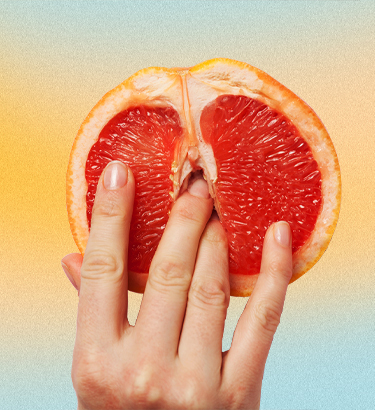Broadening your understanding of female stimulation and ways to overcome issues will help you maximize your orgasms.


Sex and the Vagina: An Owner's Manual
Welcome, owners, to what may just be your favorite guide to the vagina: Let's talk about sex. Not everyone has a true understanding of female anatomy, and pleasuring a vagina—even your own—can be a challenge. Nonetheless, there are multiple ways it, and other sensual areas, can be stimulated in order to achieve different types of orgasms. A significant number of women—5 percent—say they've never been able to come, even during masturbation. Others are fine solo but struggle to climax with a partner. Difficulty communicating with a lover, even a long-term one, about what gets you off can further complicate things. Broadening your understanding of female stimulation and ways to overcome issues will help you maximize your orgasms. As they say, know thyself.


Let's begin with perhaps the most important anatomical element of female pleasure: the clitoris. Externally, it's a fleshy, pea-shaped structure formally called the glans clitoris, found just below where the outer labia meet, covered by, or just beneath the clitoral hood. The clitoris extends internally toward your pelvic bone, and along both labia toward the anus, and can therefore be accessed through many forms of stimulation. With more than 15,000 nerve endings (8,000 alone in the glans clitoris), it's no wonder this structure plays such a key role in orgasms.
Between the inner lips is the opening to your vagina, which can be penetrated with fingers, a penis and sex toys. The perineum is the area between your vaginal opening and anus—massaging the perineal spongy tissue beneath can result in climax. Behind the perineum is the anus, a highly sensitive area that does require a few special considerations, but can contribute significantly to physical pleasure.
In summary, you have a lot of options.
Playing with the clitoris is an essential element of climax for 37 percent of women.

If you're like the majority of women, the 'as the crow flies' path to orgasm is manual stimulation, particularly if you take things into your own hands. Playing with the clitoris is an essential element of climax for 37 percent of women, according to a 2017 study of more than 1,000 ladies published in The Journal of Sex and Marital Therapy. (Using a handheld vibrator counts, too.) Up and down, circles, applied pressure, there's virtually no end to the possibilities. And the clitoris isn't the only organ deserving of attention from the hands—the vagina and anus can be pleasured with (cleaned and lubed) fingers and toys—and don't forget breasts and nipples. One key benefit of manual stimulation—it can be enjoyed alone or with a partner. A lover might play with your clitoris before and/or during penetration, or you can finger yourself to help reach orgasm while a partner penetrates you. Exploring your own path to orgasm through masturbation can improve orgasms with a partner.

Only 40 percent of heterosexual women report receiving oral sex from a male partner.


Mouth, tongue, lips—"O," my, indeed. According to a 2016 study from The Canadian Journal of Human Sexuality, 80 percent of women report enjoying receiving oral sex, or cunnilingus, and 53 percent say they have orgasmed during it. Partners can kiss and lick your clitoris, labia and vaginal opening, and penetrate you with their tongue. The perineum and anus are also incredibly sensitive (no special preparation required, just be sure to shower before). Oral can be combined with manual stimulation or toys. Unfortunately, only 40 percent of heterosexual women report receiving oral sex from a male partner, while 80 percent of women are performing it, indicating a gender gap in oral sex.

Moving along to the "main event" of many heterosexual sexual experiences, let's talk about penetrative sex. If you've ever wondered what all the hype is about vaginal sex, or wondered if any women are regularly getting off this way, you're not alone. It's true only 7 percent of women always get off solely through vaginal intercourse, according to behavioral neuroendocrinology researchers at Emory University. Which is frustrating, because a lot of guys think penis-in-vagina (PIV) sex is an instrumental part of all sexual encounters, when in reality, this alone doesn't do it for most women. That's not to say that penetration can't be great. If you're aroused and ready for it, and the position and partner are good, vaginal sex can be a great way to connect, and even orgasm together, especially if clitoral stimulation is also incorporated. Anal sex, too, can be an exciting act to engage in with a partner, and if done right (with plenty of lube) can be extremely hot. The key to penetrative sex is making sure penetration isn't the entire show, and that the opening act and the finale are equally satisfying.

Scientists are still openly debating whether the 24 different orgasms that have been identified are truly distinct.


G-spots, A-spots, O-spots: How many orgasms are you supposed to be having? A good question, and one not easily answered, as scientists are still openly debating whether the 24 different orgasms that have been identified are truly distinct, or whether they're all clitoral orgasms caused by different forms of stimulation. At the end of the day, does it even matter? Orgasms feel good, and that's all you need to be concerned about. If you're curious, women have reported orgasming through stimulation of different areas on the front wall of their vagina, including the G, O and A spots. Orgasms have also been experienced via stimulation of the cervix and the spongy tissue beneath the perineum (PS-spot), as well as during nipple play. Even fantasy orgasms, involving no physical stimulation at all, are possible. The sky's the limit, and so should your orgasms be.

Don't worry, you're not alone. Difficulty orgasming is extremely common for many women, and more often than not, it's not because the woman can't do it—it's because she's not getting the right stimulation. One of the most common culprits: engaging in PIV sex only. Add clitoral stimulation (oral or manual), and remember that sex doesn't have to involve penetration at all—rubbing your clitoris against your partner's pelvis can help you come. Positions are important, too—try being on top, which allows you to control the depth and speed. Lube can go a long way—especially tingly lubes that increase sensation.
The same survey from The Canadian Journal of Human Sexuality reported only 30 percent of women feel comfortable telling a partner what they need to orgasm. Self-exploration can get you really tuned in to what's hot and what's not for you, and make it easier for you to explain it. If you feel awkward—don't. There's nothing embarrassing about discussing your clitoris, or vagina, or the way your partner is, or isn't, getting you there. Your pleasure is just as important as theirs, and they can't know how to satisfy you without clear communication. If you and your partner are working together and you're still not coming, reach out to a sex therapist for support.



Lastly, let's talk about something a little (or a lot) uncomfortable. Sometimes sex hurts. Endometriosis, vaginismus, infections, vulvodynia, uterine fibroids, pelvic inflammatory disease (PID), reproductive cancers and their treatments—a number of medical conditions can cause pain with sex, or dyspareunia. Sometimes pain is idiopathic, or with no known cause, or psychologically linked to relationship problems or past trauma. You might feel pain in your vagina or pelvis, ranging from throbbing or sharp shooting pain to a dull ache. It may happen during sex, or not until afterward. If you're experiencing any discomfort, check in with your gynecologist, who can rule out more serious causes (such as ovarian cancer), make a diagnosis and recommend care. Treating any underlying conditions can help, as can pelvic massage and pelvic floor exercises. Taking a warm bath and emptying your bladder before sex are beneficial. So is using water-soluble lubes, and taking OTC pain medications. Make love when you're feeling relaxed and pain-free, and work with your partner to find the times and positions that minimize any problems. There are ways to manage painful sex, and it starts with being honest with your partner and your doctor.
You and your vagina deserve orgasmic satisfaction, but you can't expect your partner to know what you need if you don't know yourself. Learn about you, then educate.
There's nothing embarrassing about discussing your clitoris, or vagina, or the way your partner is, or isn't, getting you there.









